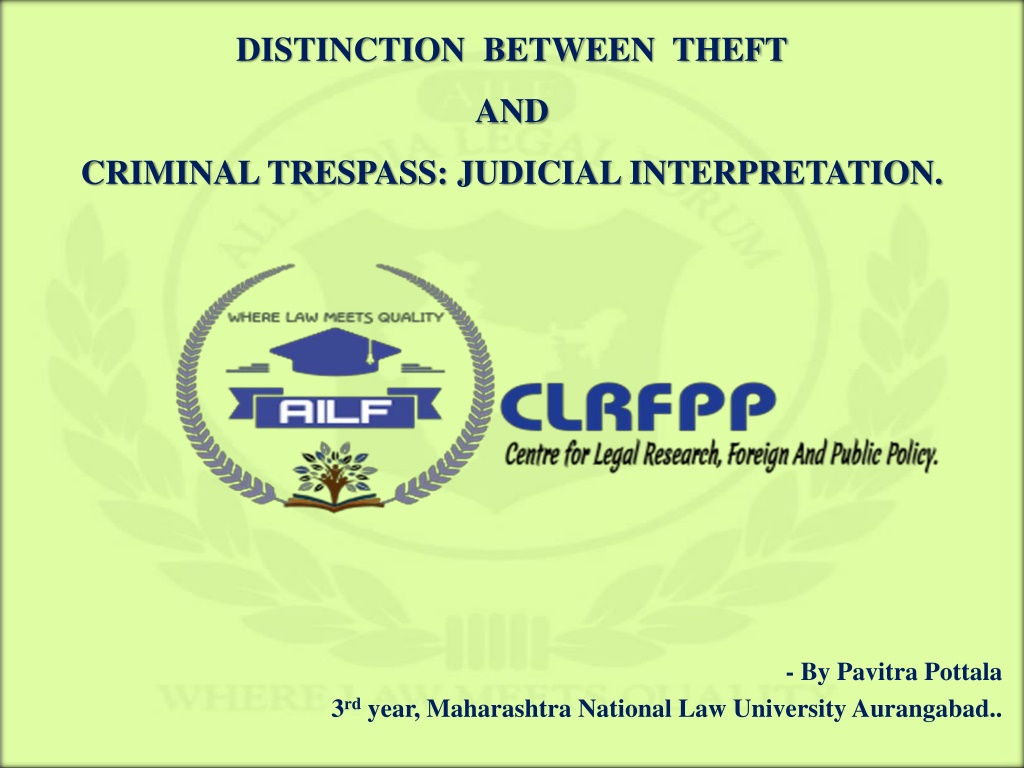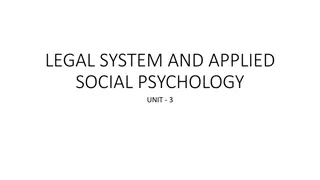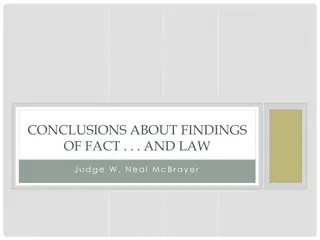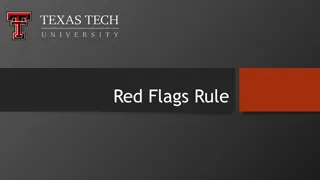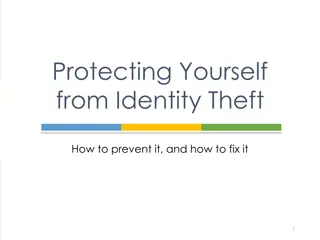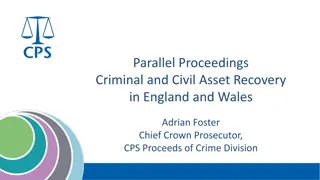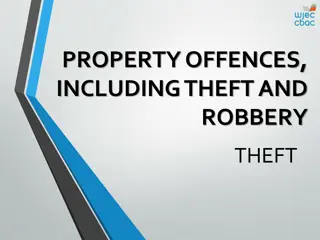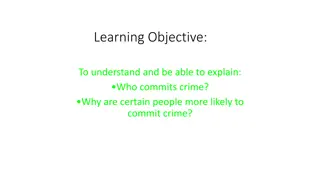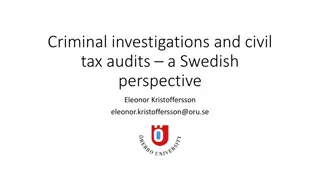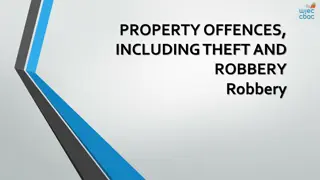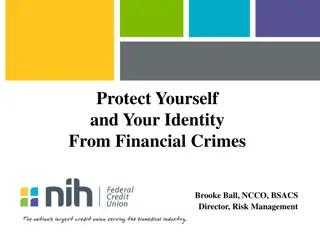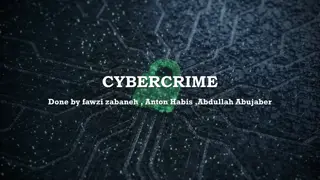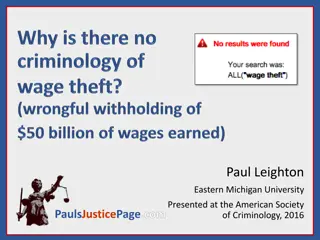The Distinction Between Theft and Criminal Trespass
Exploring the nuances between theft and criminal trespass under the Indian Penal Code 1860, this study delves into the essential ingredients, punishments, and kinds of offenses associated with each. It emphasizes the importance of judicial interpretation in distinguishing these two crimes, providing critical insights for readers to comprehend these legal distinctions effectively. Additionally, it examines the position of criminal trespass in other countries like the United States and Britain, highlighting variations in legal frameworks.
Download Presentation

Please find below an Image/Link to download the presentation.
The content on the website is provided AS IS for your information and personal use only. It may not be sold, licensed, or shared on other websites without obtaining consent from the author.If you encounter any issues during the download, it is possible that the publisher has removed the file from their server.
You are allowed to download the files provided on this website for personal or commercial use, subject to the condition that they are used lawfully. All files are the property of their respective owners.
The content on the website is provided AS IS for your information and personal use only. It may not be sold, licensed, or shared on other websites without obtaining consent from the author.
E N D
Presentation Transcript
DISTINCTION BETWEEN THEFT AND CRIMINAL TRESPASS: JUDICIAL INTERPRETATION. - By Pavitra Pottala 3rdyear, Maharashtra National Law University Aurangabad..
PURPOSE OF STUDY/SIGNIFICANCE The topic upon which the research is themed on, is the Distinction between theft and criminal trespass: judicial interpretation , thus it is important for a learner, to be well aware of the Theft and Criminal Trespass which is discussed under Indian Penal Code 1860. This research also discusses the critical analysis of the Judicial Interpretation by the court of Law and tries to elaborate the topic for best of reader s comprehension.
INTRODUCTION Indian Penal Code (IPC)1860, Chapter XVII named Offences against Property deals with the Theft and Criminal trespass. Theft is covered under the five sections 378-382 IPC and Criminal trespass is covered under twenty-two the sections 441- 462 IPC. Theft is defined under section 378 of IPC which states that who is intending to take any movable property dishonestly out of possession of person without taking that person s consent and who moves that property for taking it, is known as commit theft. Criminal Trespass is defined under the section 441 IPC which states that whoever enters into or upon the property which is in the possession of another with intention to insult, annoy or commit offence to any person who are there in the possession of such property or enters lawfully and remains unlawfully into or upon the property of another who has it s possession to annoy, intimidate, insult and commit offence is known as commit criminal trespass.
DISTINCTION BETWEEN THEFT AND CRIMINAL TRESPASS UNDER IPC, 1860 THEFT CRIMINAL TRESPASS ESSENTIAL INGREDIENTS : 1. dishonest intention 2. movable property 3. property in possession and without consent. ESSENTIAL INGREDIENTS : 1. whoever enters the property 2. Intention 3. Other s possession on property 4. property PUNISHMENT: Under Section 379 of IPC (Imprisonment which may extent to 3 years or fine or both) PUNISHMENT: Under Section 447 of IPC (Imprisonment up to 3 months or fine or with both) KINDS OF THEFT : SECTIONS 380 382 KINDS OF CRIMINAL TRESPASS : SECTIONS 442 461 1. 2. Section 380 :Theft in dwelling house section 381 :Theft done by clerk or servant in property of master s Possession Section 382 :after preparation of theft that made for causing of death, hurt or restraint from in order to committing the theft 1. 2. 3. Section 442 : House Trespass Section 443 : Lurking House Trespass Section 444 : Lurking House Trespass by Night Section 445 : House Breaking Section 446 : House Breaking by Night Section 461 : Dishonestly breaking open the Receptacle containing property 3. 4. 5. 6.
POSITION OF CRIMINAL TRESPASS IN OTHER COUNTRIES UNITED STATES : Criminal trespass in most the states in US, is punishable by misdemeanor. And some states also considered it as a Felony and they try to find out the intention behind offence of criminal trespass. Criminal trespass is imprisonment or fine as well as they also punished accused for misdemeanor or felony In US punishment for BRITAIN : In English law Under the Criminal Justice and Public Order Act 1994 Criminal trespass means Unjustifiable interference with land which is in the possession of another exclusively or tort or crime. Under English law it is not necessary that there should be any harm for considered as criminal trespass but also court before jump into any conclusion they differentiate whether trespass was accidental or intentional AUSTRALIA : In Australia according to Summary Offences Act a person must not enter anyone s house or business office s premises without proper permission otherwise it amount to criminal trespass. In Australia people have right to privacy in their homes or business premises
JUDICIAL INTERPRETATION OF THEFT & CRIMINAL TRESPASS : INDIA 1. Pyarelal Bhargava v. State (AIR 1963) One government employee took file with him from the govt. office and showed someone and bring back after two days then in this case court held that even temporary movement of the property with intention of dishonesty is amount to theft. 2. Punjab National Bank Ltd v. Federation ( 1953AIR 296) All India Punjab National Bank Employees Employees of the bank go on strike and enter the bank with intention only to put pressure on management but had no intention to insult any member of the bank, then court held that it would not amount to criminal trespass because there is no intention of the workers to insult or harm the management or any person of the bank.
3. State of Calcutta v.Abdul Sukar (AIR 1960 CAL 189) Court held that on constructive entry by servant into owner s private property there is no criminal trespass because though there was no possession of law but there is possession of fact. 4. M/s. Shriram Transport Finance Co. Ltd. v. R. Khaishiullah Khan (1993 (1) kar LLJ 62) The property was seized by financer because of hire purchase agreement defaulted then court held that it would not amount to theft by financer because intention behind seizing the property is not dishonesty. 5. Pullabhotla Chinniah Case (1917-18 CR. ) The court held that, Entering into cattle shed in which agricultural implements were stored by breaking its entrance is known as house breaking and it is a aggravated kind of criminal trespass.
6. Prem Bahadur Rai v. State (1978) Court states that if there is not taken any precaution of conceal during house-trespass then it is not covered under section 443 and therefore courts discussed some essential ingredients for Lurking house trespass which includes trespass, house trespass and conceal of house trespass from any person who has the right to eject from house. 7. RamjanMisrty v. Emperor (162 IndCas 231) Court said that it must be proved that intention of a person of criminal trespass was actual not probable.
CONCLUSION & SUGGESTION After the critical analysis I would like to conclude that, IPC discussed types of Criminal Trespass and theft also its punishments which are covered and made to protect property of citizens and their rights subject to property for the betterment of society and citizens of India. In my opinion IPC included many provisions for welfare of citizens and society regarding theft and criminal trespass and provided whole chapter subject to theft and criminal trespass hence it can be observed that it is very significant topic in the society. But due to some investigation procedure sometimes it was observed that this topics were not taken as very important topics because, in daily news theft and trespass can be observed hence, there is need of some strict provisions regarding investigation of these matters and punishment too.
